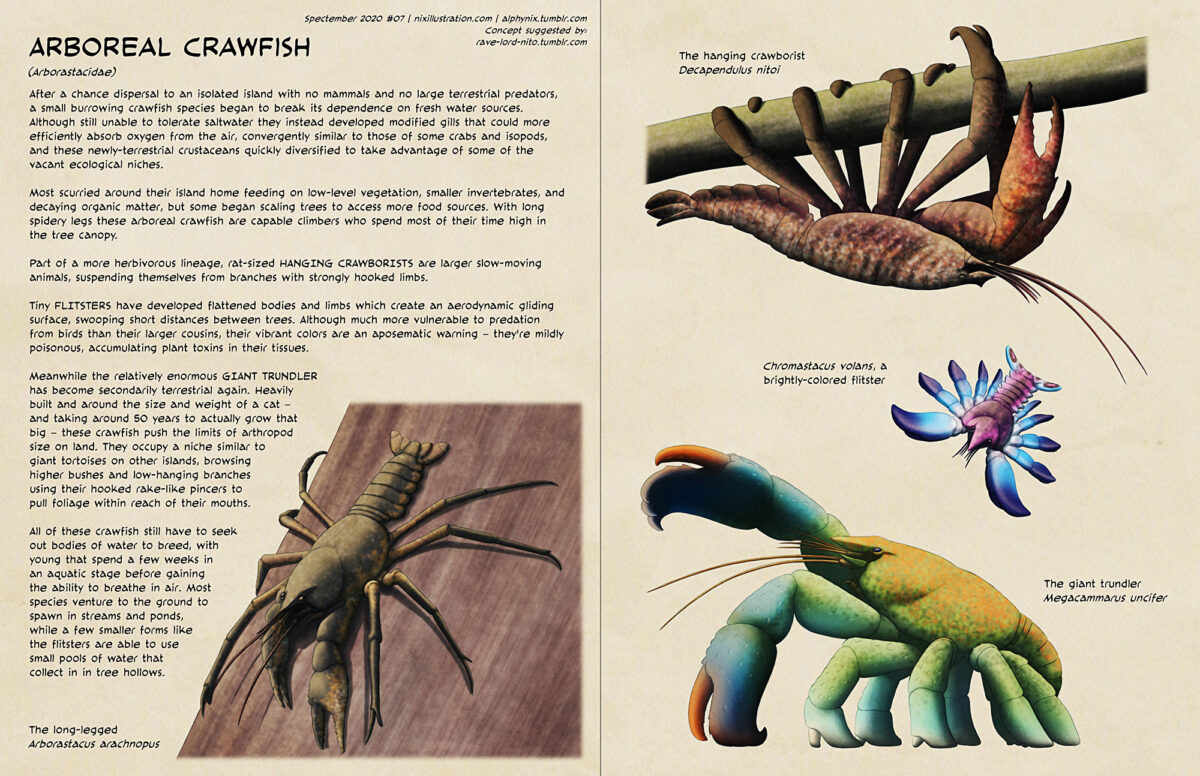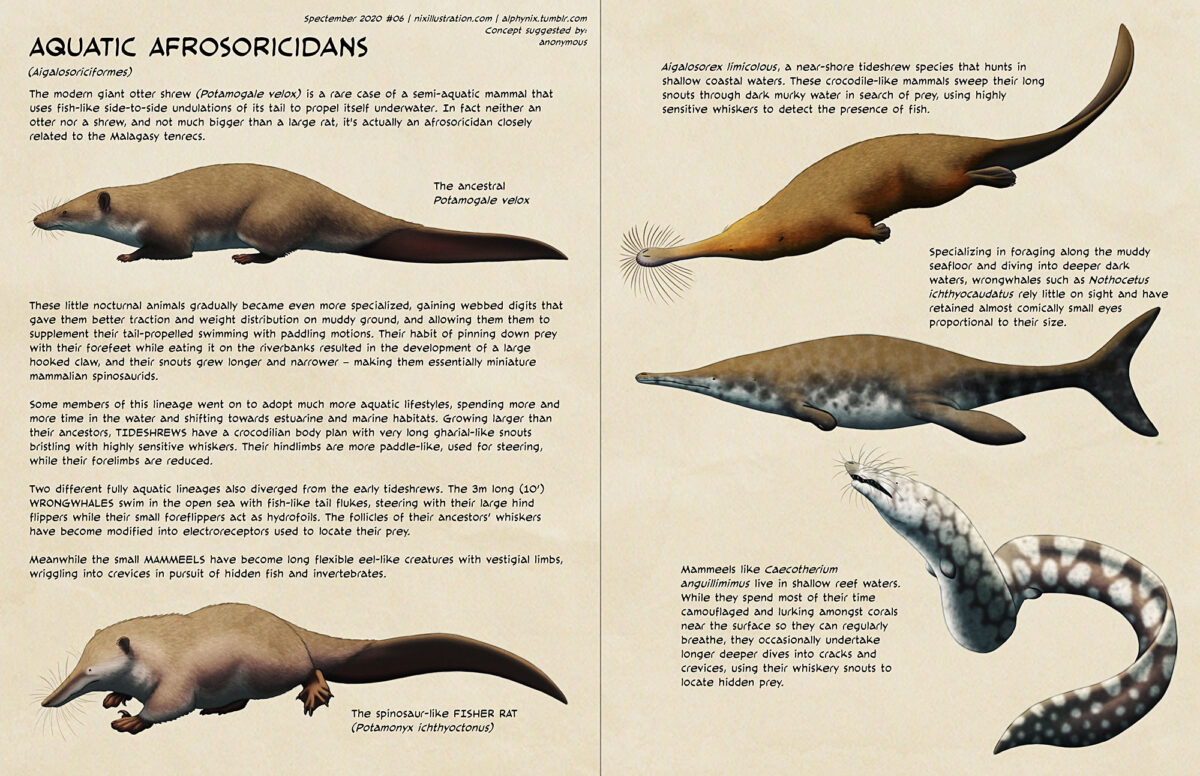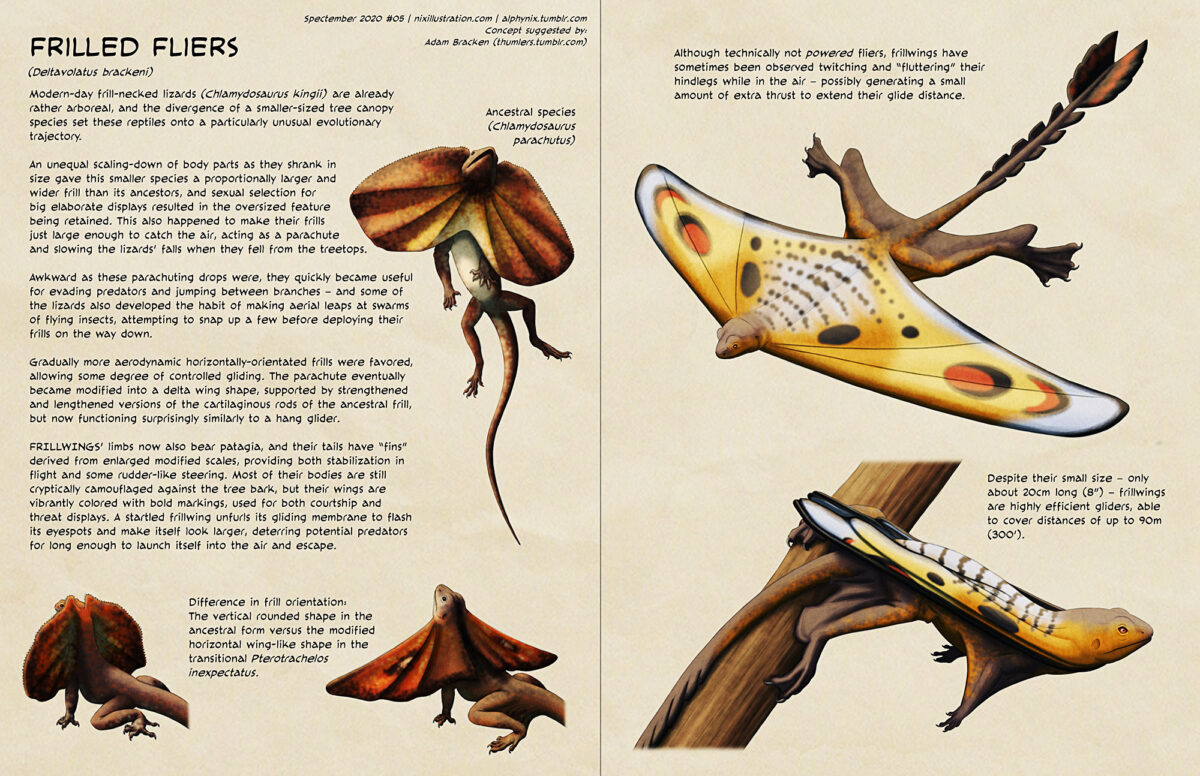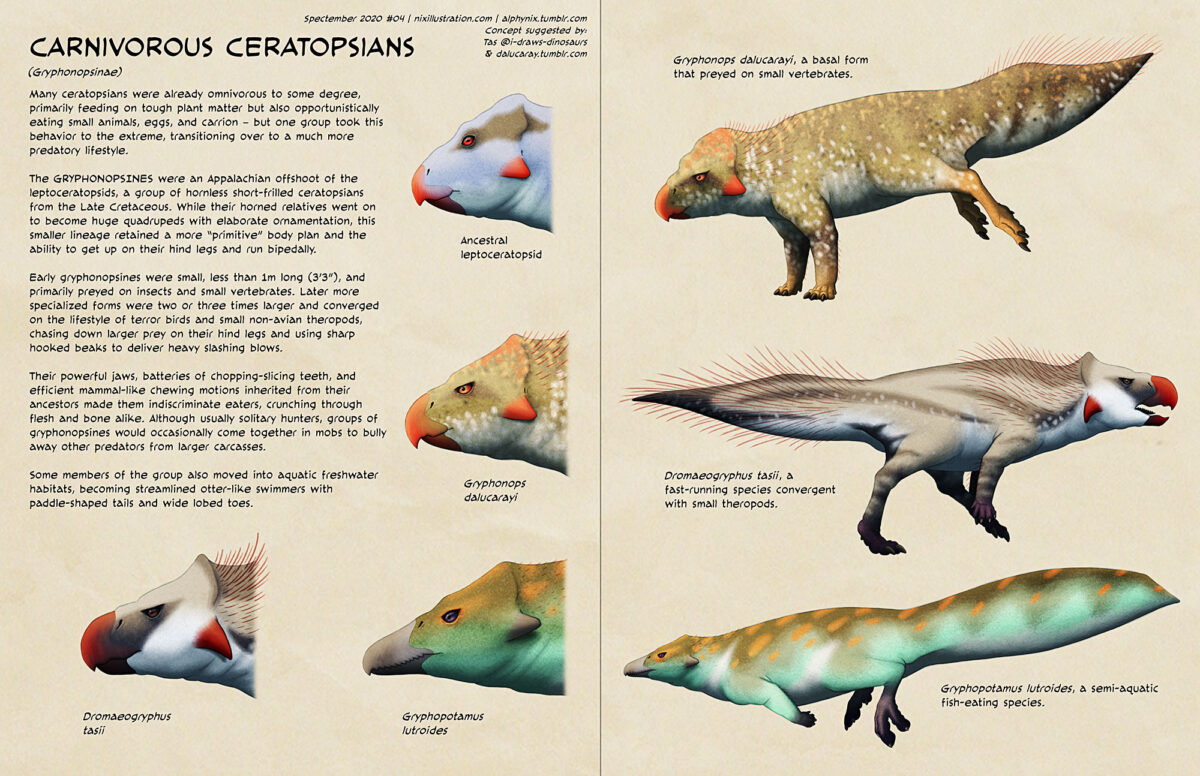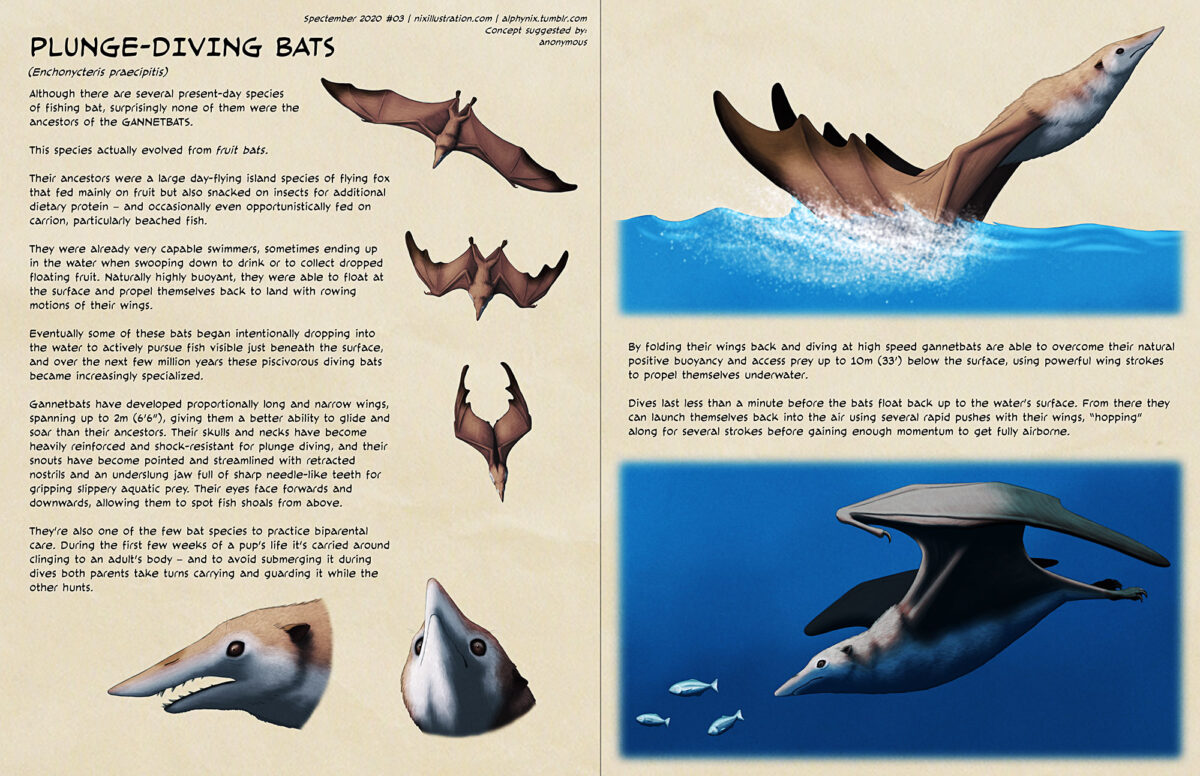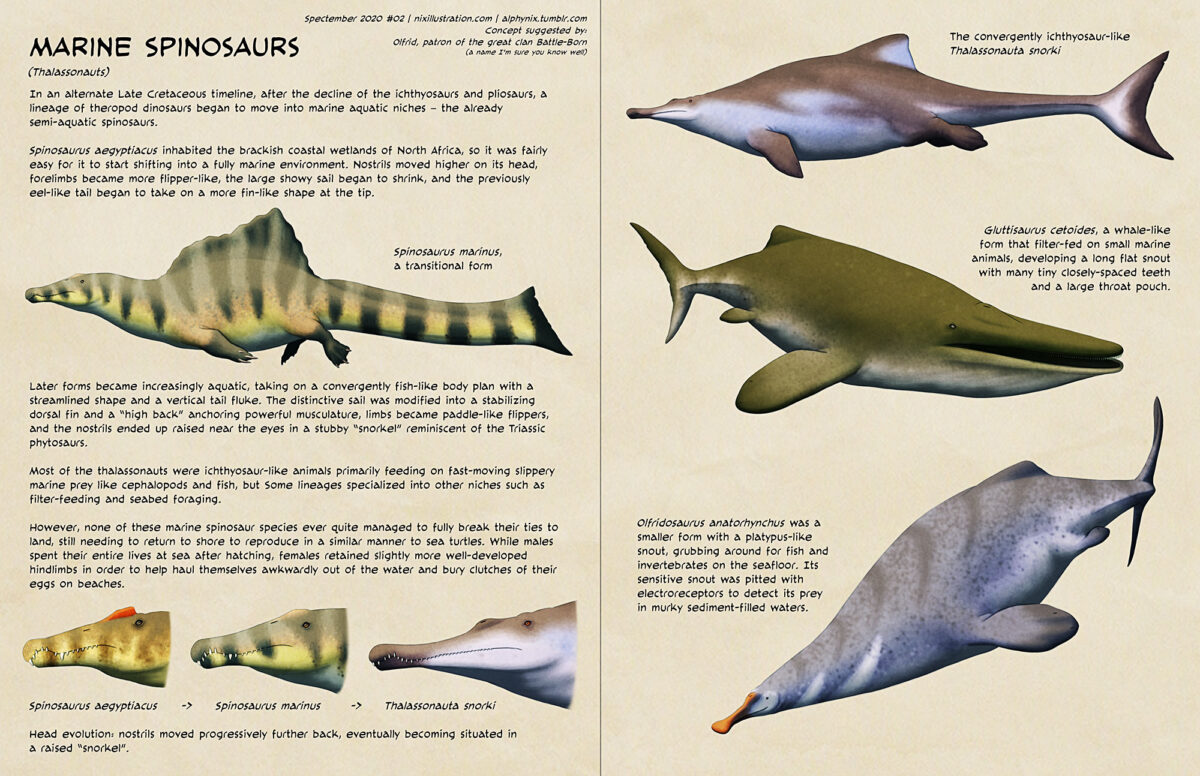Transcript for the text on the image under the cut:
Continue reading “Spectember #09: Wading Hesperornitheans”Tag: speculative evolution
Spectember #08: Giant Cavy-Ungulates
Transcript for the text on the image under the cut:
Continue reading “Spectember #08: Giant Cavy-Ungulates”Spectember #07: Arboreal Crawfish
Transcript for the text on the image under the cut:
Continue reading “Spectember #07: Arboreal Crawfish”Spectember #06: Aquatic Afrosoricidans
(The submitted prompt here was “some kind of fully aquatic non cetacean or dugong mammal with a different bodyplan”.)
Transcript for the text on the image under the cut:
Continue reading “Spectember #06: Aquatic Afrosoricidans”Spectember #05: Frilled Fliers
Transcript for the text on the image under the cut:
Continue reading “Spectember #05: Frilled Fliers”Spectember Interlude: The Saga of the Snouters
Harald Stümpke’s 1957 book Bau und Leben der Rhinogradentia (translated into English in 1967 as The Snouters: Form and Life of the Rhinogrades) is a detailed description of the anatomy, developmental biology, ecology, evolution, and taxonomy of a bizarre order of mammals known as the Rhinogradentia.
Descended from shrew-like ancestors isolated from the rest of the world during the Late Cretaceous, the lack of other animal competition on the remote Hi-yi-yi Archipelago resulted in the rhinogrades diversifying into a huge range of ecological niches. They were unique in having developed a “nasorium”, an appendage derived from the snout that was used for functions such as locomotion and feeding, and their recorded species included sedentary insectivores, ear-winged fliers, parasites, large mammoth-like herbivores, aquatic filter-feeders, flower-mimics, and miniscule planarian-like creatures with such simplified anatomy that they barely even resembled vertebrates anymore.
Sadly the entire island chain suffered ecological disaster shortly after its “discovery” by the Western world. An accidentally introduced cold virus wiped out both the indigenous inhabitants and several species of rhinograde, and then a few years later nearby nuclear weapons testing caused the entire archipelago to subside beneath the ocean’s surface – taking with it all the remaining endemic wildlife and every scientist studying them, who’d all been gathered on one of the islands for a scientific conference at the time.
(The snouters were of course an entirely fictional group of speculative animals, actually created by German zoologist Gerolf Steiner. Originating as a joke in the mid-1940s based on the nonsense poem The Nasobame, the rhinogrades were further developed and used by Steiner as an educational tool to illustrate the particular weirdness of how animals evolve and diversify in island environments – and also the fragility of those isolated ecosystems – before eventually being published in book form.
Initially the snouter book was presented with absolutely no admission of its fictional nature, and with its larger scope and dry scientific tone it can be argued to be one of the first “true” works of the speculative evolution genre. Over the years the rhinogrades have also become a beloved biological in-joke, occasionally appearing in otherwise serious publications or in April Fool’s Day stories.)
Before we move on, a rare case of speculative botany deserves a mention: Leo Lionni’s 1977 book Parallel Botany, a detailed catalogue of the history and study of an entire kingdom of strange plant-like lifeforms that appear to have only tenuous interactions with both human perception and spacetime itself. Some are invisible to the eye but show up in photographs (or vice versa), some violate the usual rules of distance and perspective, some only retroactively come into existence after discovery of their names, and almost all of them disintegrate upon being touched.
Next week: the start of the “modern” spec evo movement.
Spectember Interlude: Origins of Speculative Evolution
The concept of speculative evolution is probably about as old as the recognition of natural selection itself. In the first edition of On The Origin of Species in 1859, Charles Darwin speculated about swimming bears eventually becoming whale-like animals as a hypothetical example of the evolutionary process in action:
“In North America the black bear was seen by Hearne swimming for hours with widely open mouth, thus catching, like a whale, insects in the water. Even in so extreme a case as this, if the supply of insects were constant, and if better adapted competitors did not already exist in the country, I can see no difficulty in a race of bears being rendered, by natural selection, more and more aquatic in their structure and habits, with larger and larger mouths, till a creature was produced as monstrous as a whale.”
(This passage was widely ridiculed at the time, and most of it was removed from later editions, but compared to many modern spec projects a whale-bear doesn’t actually seem that weird!)
But it was the science fiction genre that really got things going, with H.G. Wells’ 1895 novel The Time Machine and its depiction of a future time when humans have diverged into two new species: the docile pampered Eloi and the underground-dwelling predatory Morlocks. A later chapter in the book also gives a glimpse of an even further future populated by huge terrestrial crabs – and, in some editions, small rabbit-like animals that are the distant descendants of the Eloi.
Various other works experimented with similar fictional creatures over the next few decades, both Earth-based and alien, although usually on a small scale with only a handful of species. Edgar Rice Burrough’s Barsoom and Pellucidar series featured slightly more developed speculative faunas inhabiting Mars and the interior of a hollow Earth, and Olaf Stapledon’s Last and First Men detailed a future history of humans across eighteen different species and two billion years of time.
Then, in the late 1950s came the publication of a book with some much more rigorous evolutionary worldbuilding… where we’ll continue tomorrow.
Spectember #04: Carnivorous Ceratopsians
Transcript for the text on the image under the cut:
Continue reading “Spectember #04: Carnivorous Ceratopsians”Spectember #03: Plunge-Diving Bats
Transcript for the text on the image under the cut:
Continue reading “Spectember #03: Plunge-Diving Bats”Spectember #02: Marine Spinosaurs
Transcript for the text on the image under the cut:
Continue reading “Spectember #02: Marine Spinosaurs”


